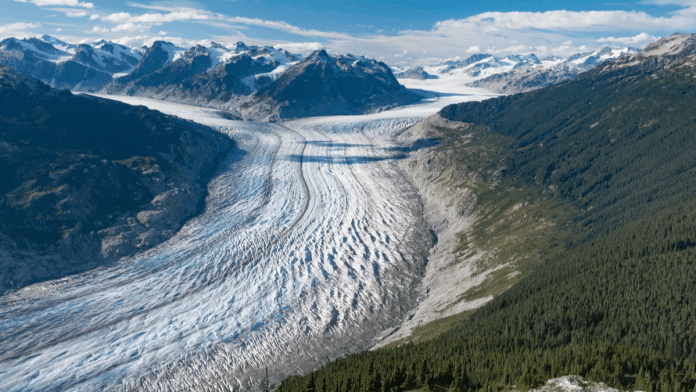🕒 Last updated on July 26, 2025
Some of the strongest glaciers in the world are found in Canada. From Alaska to the Yukon, the St. Elias mountain range is home to several of them. These glaciers are thick, vast, and ancient. Now, however, they are melting more quickly than previously.
The Silent Disappearance of Canada’s Largest Icefields
Glaciers are giant frozen rivers of ice. They flow slowly through mountain valleys, shaping the land as they move. However, temperatures are increasing due to climate change. This is causing the glaciers to shrink. Some of the smaller ones are already disappearing completely. Scientists say that even bigger glaciers, while they may last longer, are also getting thinner every year.
These changes are not just happening high up in the mountains. They’re being felt in lakes and rivers far below. When a glacier melts, it sends water into streams, rivers, and lakes. When it disappears, those water sources start to dry up.
One glacier called the Kaskawulsh melted so quickly that it changed the path of a river. In the past, it sent water through the Slims River into Kluane Lake. Now, that water has been diverted to another river. As a result, Kluane Lake has dropped by more than a meter. That may not sound like a lot, but it has a big impact on the plants, animals, and people who rely on that water.
🧱 Finland builds world’s largest sand battery — and it’s heating homes without oil or pollution
Deep Cultural Ties at Risk with Every Drop
The glaciers of the Yukon are not just part of the landscape—they are part of the culture. For generations, First Nations people have lived near these icy giants. They’ve travelled across them, held ceremonies beside them, and passed down stories that connect their communities to the glaciers.
In many First Nations languages, there are stories about how the glaciers move and how they shape the land. Elders talk about how people once used frozen trails to attend potlatches and funerals across the mountains. Some of these ancient routes still exist, but many are now disappearing along with the ice.
As the glaciers melt, younger generations may never see the same landscapes their ancestors did. Language and traditions tied to these places could slowly fade away. Many elders worry that without the glaciers, these stories could be lost, and future generations may struggle to understand a way of life that depended on them.
Water from the glaciers is also important for fish, especially salmon. Salmon swim from the ocean all the way to the end of Kluane Lake to spawn. But with less water flowing into the lake, salmon are facing tough conditions. If the water keeps dropping, the fish might not be able to reach their spawning grounds, and that could hurt local food supplies and traditions.
The transformation is evident in some areas of the Yukon just by looking out the window. Small glaciers that once sparkled on mountain peaks are now shrinking fast. People can see them melting more every summer. It’s a constant reminder that something important is being lost.
Global Attention to Local Ice
The glaciers in the St. Elias range are part of one of the largest icefields outside of the North and South Poles. These thick sheets of ice stretch across valleys and mountaintops, supplying water to rivers and lakes across a huge area. But they are also important to the entire planet.
EU sanctions shake global oil game—India’s Reliance and Nayara strike back
Scientists say that this part of Canada is responsible for about one-quarter of all the water melting from glaciers in the world—outside of the big ice sheets in Greenland and Antarctica. That’s a massive amount. When this water flows into the ocean, it can cause sea levels to rise. The consequences will therefore be felt even by those who live far from the Yukon.
Teams of researchers are now spending time in the mountains, studying how fast the glaciers are melting and what happens to the land when they do. They set up camp in remote areas, take measurements, and track how the glaciers move. Some glaciers surge forward, some retreat, and others crack apart, sending booming echoes down the valley.
But scientists aren’t working alone. They are also learning from the local people—the First Nations whose knowledge has been passed down for thousands of years. This knowledge helps researchers better understand how the glaciers behave and how the land has changed over time.
Climate Convergence Has Begun: 6 Global Systems Are Collapsing at Once
People living in the Yukon are doing what they can to share their stories, protect the ice, and build connections with the scientists studying it. Some say it’s their responsibility to care for the glaciers, just as the glaciers have cared for them.
And while the thickest glaciers might stay for many more years, the smaller ones are vanishing fast. The land, the water, and the people are all feeling the shift.

